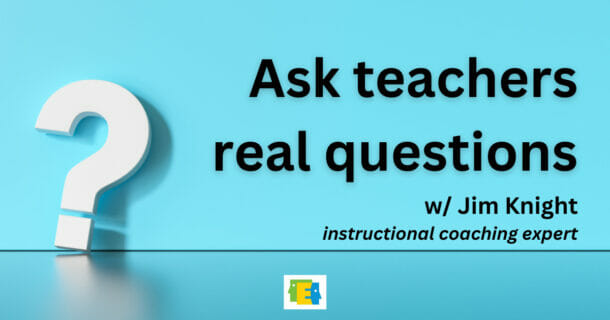Jim Knight on How To Ask Questions That Highlight Teacher Brilliance

A good question shines highlights the brilliance of the teacher, not the brilliance of the person asking the question.
That’s according to Jim Knight, author of “The Definitive Guide to Instructional Coaching,” when asked about the purpose effective questioning techniques serve.
For instructional coaches supporting teachers, asking questions can be a key component of coaching conversations.
Instructional coaching expert Jim Knight shared with us two types of questions coaches ask teachers: real questions and leading questions.
Can you guess which is more effective?
In this PLtogether Lounge Talk with Jim Knight and Edthena founder Adam Geller, the two discussed how teacher coaches can ask teachers stronger questions by working on asking real questions.
Watch the full conversation down below or read on for highlights about the difference between real and leading questions and ways instructional coaches can strengthen their questioning techniques.
What is the difference between real and leading questions?
Coaches and professional development leaders use effective questioning techniques to engage with teachers.
Jim Knight’s view on what makes a question strong?
A coach’s genuine curiosity.
“A real question [conveys to teachers] ‘I’m really interested in what you have to say,’” said Jim.
An instructional coach asking a real question during a coaching conversation believes that the teacher has something valuable to say.
Jim Knight explained more about a real question, “it does not lead [teachers] to a predetermined destination.”
Leading questions, instead, do have a response that the instructional coach is expecting or assuming.
Often, a leading question involves something a coach wants a teacher to agree about.
This is an example of a leading question: “Don’t you think using whiteboards would increase your classroom engagement?”
The teacher coach is likely thinking that is a good idea and that the teacher will, too.
On the other hand, a real question could sound like, “You’ve thought a lot about classroom engagement. What are you thinking you might do?”
Jim Knight credited that example of a real question to coaching expert Michael Bungay Stanier.
Jim reflected, “I love that real question because it starts with a presupposition of the teacher having valuable things to share and then it gives them control.”
Jim Knight on how instructional coaches can avoid the “advice trap”
For Jim Knight, effective coaching conversations take place when instructional coaches ask teachers real questions that convey genuine curiosity and trust in the teacher.
But many coaches ask leading questions at times.
They’ve fallen into the “Advice Trap.”
Again citing Michael Bungay Stanier’s work on effective coaching, Jim Knight shared that research shows people think their advice is more valuable than it is.
This can result in instructional coaches thinking they know the best answer or solution for a classroom, and that the teacher wants their advice.
Sometimes teachers do agree with a coach’s advice, but don’t follow through.
Why not?
Jim Knight said this is because teachers need to own the solution.
The instructional coaching expert said:
“I want the teacher to have the energy. I want the teacher to be doing the thinking.”
When a teacher grapples with a classroom or instructional issue, they come to a solution that is important to them. This is instead of a coach offering them an easy suggestion disguised as a leading question.
Real questions during a coaching conversation invite a teacher to think deeper and take control of their own professional learning and development.
Asking teachers leading questions? How to turn them into real questions
Instructional coaches may find that they’ve been asking teachers leading questions during coaching conversations.
Here’s how Jim Knight shared instructional coaches can determine if a question they are asking is leading or real: If a teacher can answer a coach’s question with “no,” that is an ineffective question.
For example, if a teacher coach asks, “Could more checks for understanding increase student participation?” … a teacher could disagree.
The coach has essentially told the teacher what to do in their classroom but disguised it as a question.
A stronger question to ask teachers could be, “When you’ve had an issue with student participation in the past, what has worked?”
A teacher can’t say “no” to this question and it invites them to go deeper by showing the coach’s genuine curiosity.
Stronger questioning techniques start with real questions
Effective questioning techniques for instructional coaches, according to Jim Knight, shine a spotlight on the teacher rather than the coach asking the question.
Real questions encourage teachers to think deeper, grapple with challenges, and arrive at solutions that are meaningful to them.
By employing real questioning techniques, instructional coaches can foster a collaborative and empowering environment that supports teachers in their professional growth and helps them unlock their own brilliance.
Curious how new AI technology can expand instructional coaching capacity? Try AI Coach now.
Want more insights from instructional coaching expert Jim Knight? Check out this blog post: Curious about the Jim Knight Coaching Model for Teachers? Let’s Break it Down
Watch the full conversation about stronger questioning techniques with Jim Knight below.

